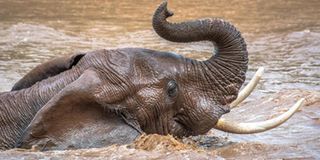Tragic end for famous Samburu bull elephant, Sarara

Sarara, 32, an iconic elephant bull which tragically died in Samburu National Reserve on December 28, 2022
Sarara, one of the most beloved and famous bull elephants in Samburu National Reserve has died.
Scientists from Save the Elephants, a research and protection organisation, said that Sarara was a victim of increased human-wildlife conflict which worsened in Samburu during the ongoing drought.
In 2021, Sarara was speared by unknown individuals and sustained injuries that needed urgent medical attention.
He was treated for his injuries and recovered quickly, gaining enough strength to make it through the crippling drought that ravaged Samburu County and other parts of the country.
However, the carcass of the 32-year-old wild bull, who was in the prime of his life, was discovered to the south of Buffalo Springs National Reserve.
Save the Elephant said his tusks were intact and were retrieved by the Kenya Wildlife Service.
"We suspect that he (Sarara) was the victim of conflict in an area known as the Attan Swamp," Save the Elephant said in a statement.
Large numbers of elephants had congregated in the Attan Swamp due to the fresh, lush grass following the return of rains in the region.
The research organisation said Sarara was a curious, lovable elephant that kept researchers on their toes during its frequent visits to the research camp in Samburu East.
"From sauntering through our car park, using our trees as scratching posts, (to) walking off with our tracking collars and breaking our walls in his exuberant effort to reach acacia trees, his antics captivated everyone, visitors and film crews alike," said Save the Elephant.
Save the Elephant’s Director of Field Operations David Daballen said Sarara's death is a reminder of the never-ending human-wildlife conflicts in northern Kenya.
Mr Daballen revealed that one in four elephant deaths in the north is caused by a conflict with people.
“Sarara’s death is a harsh reminder of the challenges we face as human-elephant conflict escalates across northern Kenya. We believe that Sarara may have been shot. At this stage, we are unsure of the motives behind his killing, but we are working with Kenya Wildlife Service and talking to local communities to get a better understanding of the situation," he said.
This is the third iconic elephant to die in Samburu National Reserve within a year.
In May this year, Martha Washington, the age-old matriarch of the First Ladies group of elephants and celebrated Kenyan elephant died. But scientists said the elephant died of old age but noted her condition deteriorated during the drought that ravaged Samburu County.
And in November this year, one of the infamous twin elephants born in Samburu also died in the wake of prolonged droughts that swept through the region.
The miraculous twins were born to Bora from the Winds family in January this year.
The severe drought and overgrazing by livestock led to a catastrophic shortage of food for elephants and other wildlife in the region.
The twin calves were first discovered in Samburu National Reserve in January and their discovery made international headlines.
But there were concerns that the twins, which are rarely encountered in wild elephant herds, would not survive.
Just like humans, elephants can die far earlier than their old age due to natural causes or due to human related activity such as poaching.





